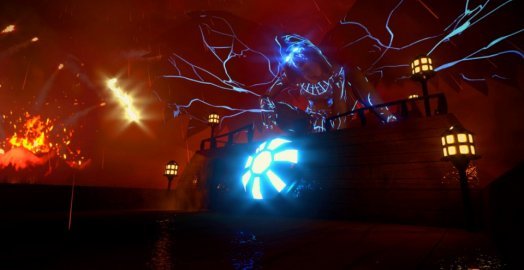Review for Soul Axiom

Note: Since time of writing, this game has been re-released as Soul Axiom Rebooted with a variety of upgrades to improve user experience. This review is based solely on the original version.
About a quarter of the way through Soul Axiom’s twelve distinct levels and expansive hub world, I fully believed I had found a worthy, much more ambitious follow-up to 2013’s Master Reboot. By the halfway point, that ambition had begun feeling counter-productive, as recycled gameplay elements, awkwardly-implemented new mechanics, and a needlessly fragmented narrative backdrop began to erode the benefits of a wealth of puzzles and diverse set of environments to explore. Three-quarters in, I really just wanted to be done with it, having given up trying to make any sense of the miniscule, disparate story scraps and feeling like I was riding out a string of “more of the same but different” to reach an ending I no longer cared about.
Had I stopped there, my reaction to Soul Axiom would have been decidedly mixed, but still generally favourable. Like its predecessor, it’s a bold blend of genre-defying gaming, mixing free-roaming 3D exploration with puzzle-solving and a bit of light action throughout a series of surreal worlds. Where this one started going wrong was in believing the lie that bigger is always better. I appreciated the effort to inject spatial manipulation abilities, but they proved frequently clunky to wield in the precise fashion required. I was impressed by how different each new area felt from the last, but this created a sense of random pointlessness. And by parceling out a nigh-incomprehensible story in piecemeal collectibles, there was rarely any narrative momentum to drive the experience forward.
So, ten-odd hours in, Soul Axiom had become an exercise in diminishing returns, but with enough left in total to recommend to those who enjoy games like Portal and its ilk. But of course, I couldn’t stop there in a title I was reviewing, so I hoped for a big finish to redeem its otherwise forgivable faults. Master Reboot made the horrible mistake of turning the finale into a brutally timed, multi-part action sequence, and surely the developers wouldn’t make the same mistake twice, right? Right. They made a much worse one, by pulling the carpet out from under the player’s feet and sending them all the way back to the beginning.
Ever play the board game Snakes and Ladders? It’s a simple dice game in which you try to ascend to the top, with ladders helping you climb and snakes sending you plunging back down. Lurking somewhere right near the end is an extra looooong snake that plummets you almost back to where you started. That snake is in Soul Axiom (figuratively speaking). And what’s worse, here you can’t avoid it. It’s one of the most obnoxious stunts any game could pull, and it’s utterly inexcusable. Having completed the twelfth and final level, I was braced and ready for a big endgame, only to find myself back in the hub world twiddling my power-infused thumbs. A little aimless wandering and one “where did that come from?” gameplay level later, an ever-helpful hologram informed me that the purple “corrupt memory” cubes I’d seen in passing but could not collect or repair the first time through each world now had to be retrieved.
At this point I longed for the days of boxed games again, so I could physically drop-kick this one across the room in rage. Instead, I dutifully went all the way back and started over, gritting my teeth and cursing profusely. Now, to be fair, you don’t have to complete each level again a second time, only reach their respective cubes. But if the “bigger is better” mantra has taught us anything, it’s that most of them were never going to be easily or quickly accessible. Some of them are even hidden, making it possible to miss them entirely. So you will indeed need to solve many of the same puzzles, sneak past many of the same enemies, leap many of the same hurdles, and fumble with all the same finicky controls before you reach your prize. I don’t think you need to get all twelve in order to proceed, but I did anyway, so I can’t promise that for sure. It’s most of them, regardless.
The good news in this wretched scenario is that once each memory cube has been accessed, it opens up another whole new level. And admittedly, that’s a pretty big plus, essentially doubling the scope of the game, albeit one that’s already bordering on overkill by that point. But it’s just not worth the imposed repetition to get there. Master Reboot also frequently followed up an original level with a distinctly different one, but it did so immediately afterwards with no extra requirements. That was an inelegant solution, as it was never clear why one abruptly transitioned to another, but at least it respected the player’s time, unlike its sequel.
For better or worse, this new set of twelve levels is also far more action-oriented than the first. Apart from the twitchy controls, there’s nothing a decent action gamer can’t handle, but adventure gamers lulled by the more leisurely pace of Soul Axiom in the first go-round may not be so enthused to find themselves running, jumping, and fidgeting in power gloves with sweaty hands under extreme duress. Only after completing enough of these levels can you finally access the final boss fight. (Oh yeah, remember when I said this game wouldn’t possibly finish with a frustrating pulse-pounder sequence again? I lied. It was just moved way, way farther back.) Actually, there are three different endings possible, and only two of them involve boss fights, but one is a freaking doozy (further complicated by a bug that forced me to restart just when I’d almost won – déjà vu or what?).
But now that you know how it ends, let’s back up a little ourselves. [Land on snake, go back to tile 22.] Called a “spiritual successor” to Master Reboot – an ironic description for a series in which human souls are converted to digitized memories for posterity – Soul Axiom is for all intents and purposes a proper sequel. You don’t need to play the first game to understand the second (such that you’re ever actually able), but it will certainly help you grasp the intricacies of the virtual reality afterlife in which it’s set. The names may have changed, but the premise is the same: you are an unnamed, unseen soul who has recently been uploaded to Elysia, an extension and refinement of the Soul Cloud, the cyber-system that went so disastrously wrong the first time around. If your bewildering introduction to this world is any indication (pirate ships, dark angels, desert bars and hover bikes… whaaaa??), something has obviously buggered up again. It’s your job, apparently, to enter the twelve saved memories of those who have come before you, but the who/where/why questions remain persistently murky throughout.
And really that’s about it for story. Unlike the first game, here you are following in the virtual footsteps of multiple people instead of unlocking your own lost memories, and the result is inferior. It’s bigger, but it ain’t better. Master Reboot was just as chintzy with its story snippets, but because the collective levels represented a single life in chronological order, it was much more intuitive to follow. The switch to several lives, only loosely intertwined in the formation (and abuse) of Elysia, eliminates any such narrative cohesion. Whereas the first game seemed designed to make you feel like you were unravelling a compelling mystery one piece at a time, Soul Axiom seems intent on leaving you largely in the dark, sometimes to the point of being deliberately misleading. Even at the end [land on ladder, move to tile 88], when all blurry cinematic memories have been accessed, your hub refuses to assemble their holographic artifacts in sequential order for a more enlightening cutscene replay.
What the multi-character approach did do was free the developers to make each world radically different. The first set of twelve levels is based largely in reality, but it’s an eclectic mix of scenarios both indoors and out. You’ll venture through Aztec ruins in a lush jungle, traverse a remote sandy island chain, navigate a futuristic space station, and explore a werewolf-themed castle, along with more standard deserted buildings like a museum, university, hospital, and church with its accompanying graveyard. You’ll even travel through time itself as you investigate an apartment across four different periods. There’s also an ice palace and lava levels for even more environmental contrast – no water level, though (I was disappointed, although you do get dunked and left gasping for air at one point).
The second set of levels is far trippier. One minute you’ll be hopping around massive gears and desk equipment, the next you’ll be trying to save a whole metropolis of skyscrapers under siege; accomplish those tasks and you’ll find yourself fleeing a rampaging dinosaur and dodging obstacles atop parallel speeding trains. But it’s not just the situations themselves that are so different, but the presentation as well. Whereas the initial levels look relatively lifelike in fairly crisp 3D detail, the latter levels are highly stylized with a Tron-like aesthetic, brightly glowing in neon blue but without physical detail. Soul Axiom may not be cutting edge, as it lacks texture up close and relies far too much on darkness to provide atmosphere, but it looks sharp. It’s a definite step up from its predecessor and certainly can’t be accused of lacking in variety.
The sound work is laudable too. You need a whole lot of audio to fill this much game time, and Soul Axiom offers enough to continually keep things fresh. Rather than any standout tunes, the soundtrack provides a diverse set of scores to suit their respective settings. From tribal chanting to soothing choral sounds; from eerie tonal notes to sci-fi synthesizers with an almost fairy tale feel, interspersed judiciously with long periods of silence, the mood is continually enhanced by the background musical selections. Voice-overs are restricted to promos and memories, but ambient effects contribute subtly to immersion, whether the lapping of waves and crunch of footsteps on a beach, lasers crackling in a protective barrier, or sentry guns blasting you to bits (I didn’t say they were welcome sounds, only effective).
Speaking of lasers, you’ll need to align a ton of them before you’re through. Repetitively so, among the astounding number of puzzles to solve along the way. There’s a bit of inventory use, though collected items appear as on-screen icons and are used automatically when needed. But there are also plenty of conventional logic challenges: you’ll crack codes with riddled clues (some useful, some infuriatingly obtuse), solve a giant mirrored chess game, match portraits with their correct descriptors, play a Minesweeper-like minigame, and solve a difficult musical challenge – and remember, at least some of these you’ll be stuck doing twice. You must also make your way through one of the most disorienting mazes you’ll likely ever encounter. All that is largely cerebral, but player dexterity will also be put to the test on many occasions, whether darting through fatal traps, shooting wave-after-wave of deadly crows, timing critical jumps (never an easy task in first-person games), sneaking past roving robotic guards, or racing around activating equipment in a very limited time.
In most adventures, the philosophy is to pick up everything that isn’t nailed down. In this case it’s to give it a twirl. Everywhere you go it seems like there’s something to rotate, whether reflective crystals, statue segments, giant rings, coloured cubes, stone columns, pipe pieces… you name it. Really the theme song should have been The Byrds’ “Turn! Turn! Turn!” And this is where the new abilities come in. Most of the 3D controls are straightforward: WASD to move, mouse to look around, and other keys to interact, crouch, and clumsily climb ladders if the game feels like letting you. Where Soul Axiom further departs from Master Reboot is in giving you power gloves with varying functions. You start out with a simple “phase” ability that turns certain solid objects intangible, while later powers let you manipulate movable items and shoot projectiles, plus a final glove with a single, very particular purpose.
This addition opens up a slew of opportunities for organic problem-solving on the fly – not that it’s ever explained why so many strange obstacles exist. Unfortunately, it comes with two major drawbacks. The first is that it can be hard to tell which items can be manipulated. That shouldn’t have been an issue, as interactive objects are supposed to be telegraphed by colour-coding: the blue glove can only affect highlighted blue objects; same for green and orange. The problem is that many environments are so dark that it’s often hard to make out the faint glows. Maybe it was just me, but I swear that some items wouldn’t glow at all unless you had the right glove equipped. That adds to the challenge, but only in the way that pixel hunting does in traditional adventures. Carefully scouring large, sprawling environments looking for dimly-lit coloured outlines is no more fun than it sounds.
The far bigger issue is purely mechanical. Gloves are easily exchanged with either the number keys or mouse wheel, and are used via some combination of left and right mouse buttons. (In a nice touch, the equipped glove with accompanying target reticule will appear on-screen in front of you, but if not used for a time, it disappears until recalled or swapped out.) Their responsiveness, however, is a whole other matter. Countless times I clicked and held a button, expecting the current power to begin functioning, only to realize moments later that nothing was happening. I’d have to stab at the button again a second time to get the glove to trigger. (Because I like nothing more than repeating the same actions twice.)
Even when it did respond, the foremost power proved a nuisance to successfully operate. The green glove has a kind of vague, multi-purpose “move” ability, requiring players to click-hold one mouse button, then tap the other to lock the (usually rotating) piece in place. Even in theory that seems unnecessarily cumbersome, and indeed it’s a slog to use in practice. It seems objects were programmed to stop at predetermined points along their tracks, and although often that was sufficient, I lost track of how many times the object in question either slid past the desired position before stopping or came up just short of the intended point. Usually such imprecision was nothing more than a minor aggravation, but the faster the action ramps up, the more crucial it is to function with pinpoint accuracy. And that’s when everything is working properly. I encountered one stage that obviously glitched up, because no matter what I did or how often I tried, I could not get one ring to align properly. After a complete shutdown and reboot, it worked the first time.
Sadly, this wasn’t the only bug I encountered, some of them deal-breakers. At least three different times I was forced to quit out of the game because it had entered an unwinnable state, with necessary objects either not appearing or equipment failing to operate. One of those was in the middle of the final stage of the hardest endgame battle! No problem for a game that generously autosaves, perhaps, but you haven’t been paying very close attention if you think Soul Axiom does that. No, if you exit a level before completing it entirely, ALL progress is lost, and you’ll need to replay it from the beginning when you resume. The lone exception to that rule, at least in my experience, was that final battle, which at least let me skip the combat preamble after a restart.
With all these mounting complaints, it’d be easy for me to write off Soul Axiom. But the truth is, I’m more angry at the game than I am critical of it. There are so many good things here: it looks nice and sounds good, and in an era of ever-shortening games, this one bucks the trends by offering an enormous amount of content, even without the disgraceful repetition. The sheer variety of environments is staggering, matched only by the diversity of genre-blending gameplay. If only the developers hadn’t gotten so greedy, pushing for more and more and achieving less and less. Had they chosen to refine the controls, tighten the ridiculously fragmented story, and remove the unwanted padding, this would have been a stellar 15-hour adventure. As it is, I can only recommend the game to those willing to sift through the entire 25-hour experience to find it. Personally, I missed the leaner, better-focused simplicity of Master Reboot; with all the added filler this time around, even as I was freeing souls it felt like my own was being crushed.































